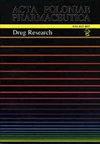现代分析技术在复杂天然基质分析中的应用——以蜂毒为例
IF 0.4
4区 医学
Q4 PHARMACOLOGY & PHARMACY
引用次数: 0
摘要
蜂毒(HBV)是一种天然产物,其成分极其复杂。它具有多种有益的药理特性,例如抗炎、抗菌、抗糖尿病、抗关节炎和抗肿瘤活性。另一方面,HBV含有高致敏成分,包括蜂毒肽,它占其干重的50%以上。尽管进行了许多研究,但HBV的成分和作用机制尚不完全清楚。因此,为了提高其治疗应用的安全性,有必要确定HBV的组成和生物学特性。据报道,许多分析技术和方法有可能用于测定新的HBV成分。研究主要集中在HBV蛋白质组和代谢组的分析上。此外,正在研究其成分在皮肤上的特性以及致敏性。目前,最常用的HBV分析方法包括高效液相色谱法和质谱法。选择正确和最适用的HBV分析方法对于获得深入的结果至关重要,这对于理解其生物学作用机制至关重要。HBV中化合物的多样性也需要在分析前阶段进行适当的样品制备。为了总结复杂天然产物分析技术的最新知识,以HBV为例,本文讨论了HBV特征的现代分析工具,重点是代谢组学和蛋白质组学研究、局部应用、毒液过敏的研究以及未来研究的前景。本文章由计算机程序翻译,如有差异,请以英文原文为准。
Application of modern analytical techniques in the analysis of complex matrices of natural origin on the example of honeybee venom
Honeybee venom (HBV) is a product of natural origin with an extremely complex composition. It exhibits several beneficial pharmacological properties, for example anti-inflammatory, antimicrobial, antidiabetic, anti-arthritic, and anti-tumour activities. On the other hand, HBV contains highly allergenic components, including melittin, which makes up more than 50% of its dry weight. Despite many studies conducted, HBV's components and mechanism of action are not yet fully known and understood. Therefore, to enhance the safety of its therapeutical applications, it is essential to establish HBV's composition and biological properties. Many analytical techniques and methods have been reported as potentially useful for the determination of new HBV constituents. Studies focus mainly on the analyses of the HBV proteome and metabolome. Also, properties of its components when applied to the skin, as well as its allergenicity, are being studied. Currently, the most commonly used methods for HBV analysis include high-performance liquid chromatography and mass spectrometry. Choosing the correct and most applicable method for HBV analysis is of great importance in order to obtain in-depth results crucial for the understanding of its mechanism of biological action. The diversity of chemical compounds in HBV also entails an appropriate sample preparation at the pre-analytical stage. In order to summarise the latest knowledge on techniques for the analysis of complex natural products, on the example of HBV, this review paper discusses the modern analytical tools of HBV characterisation, focusing on metabolomic and proteomic studies, topical applications, investigation of venom allergies, and the prospects for future research.
求助全文
通过发布文献求助,成功后即可免费获取论文全文。
去求助
来源期刊
CiteScore
0.80
自引率
0.00%
发文量
74
审稿时长
6-12 weeks
期刊介绍:
The international journal of the Polish Pharmaceutical Society is published in 6 issues a year. The journal offers Open Access publication of original research papers, short communications and reviews written in English, in all areas of pharmaceutical sciences. The following areas of pharmaceutical sciences are covered: Analysis, Biopharmacy, Drug Biochemistry, Drug Synthesis, Natural Drugs, Pharmaceutical Technology, Pharmacology and General.
A bimonthly appearing in English since 1994, which continues “Acta Poloniae Pharmaceutica”, whose first issue appeared in December 1937. The war halted the activity of the journal’s creators. Issuance of “Acta Poloniae Pharmaceutica” was resumed in 1947. From 1947 the journal appeared irregularly, initially as a quarterly, then a bimonthly. In the years 1963 – 1973 alongside the Polish version appeared the English edition of the journal. Starting from 1974 only works in English are published in the journal. Since 1995 the journal has been appearing very regularly in two-month intervals (six books a year). The journal publishes original works from all fields of pharmacy, summaries of postdoctoral dissertations and laboratory notes.

 求助内容:
求助内容: 应助结果提醒方式:
应助结果提醒方式:


